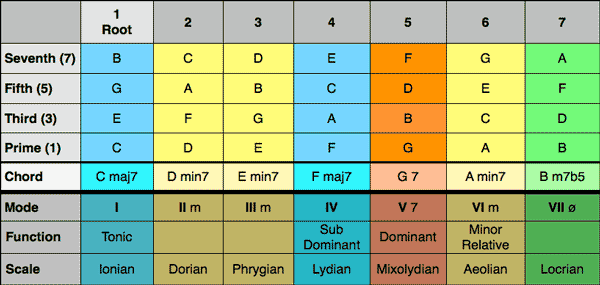
4 - Music Theory
A Song has a harmony (a chord progression), which is played by the rhythm guitar player and a melody (scales and arpeggios), which is played by the soloist.As a beginner in the Jazz business, you may wonder, why especially those chords are played and not others. Professional musicians know exactly, which notes they can play over these chords. Other musicians have no idea and just try to play by feeling, trial and error.
There are many Jazz method books available in the world, and the best, to get deep into Jazz theory.
Here I want to explain you just the basics you need to get into the Gypsy Jazz. And you will get some hints too, where Djangolizer will help you practicing.
Here you will get in touch with terms and definitions as:
- the music system of the western world
- accidentals (sharp and flat)
- tonality
- major and minor
- major scale
- intervals
- chord structure
- chord families
- minor relative
- the music system of the western world
- accidentals (sharp and flat)
- tonality
- major and minor
- major scale
- intervals
- chord structure
- chord families
- minor relative
The western music system
The western music, was founded by the greeks and enhanced in the middle ages by monks. Today we have a system with 12 tones, with a distance of halftones between them.When we play through all the 12 tones (chromaticaly), we will arrive at the same start tone again, but one octave higher.
These 12 tones are named with the 7 first letters of the alphabet.
A B C D E F G
Let's call them notes.
For some reason, the notes start with the C…
C D E F G A B
The accidentals flat and sharp
Now we have 12 tones, but seven names. Therefore the notes in between will be raised by the # (sharp) sign and lowered by the b (flat) sign.For example:
C# = C sharp
Db = D flat
C# means, that the tone is a halfnote higher than C
The same note can be written as Db as well, what means, that it is a half note lower than D.
The two notes C# and Db describe the exact same tone.
Our chromatic row of notes looks like this:

Right now, these notes have still no meaning. They are a bunch of lazy tones without any structure nor any tension.
Each one of these 12 notes can be the root note of a song.
A Song and his tonality
Each song has a tonal center!When you listen to a song, grab your instrument and play around for a while. For sure, you will find a tone, which sounds right all the time through the whole song and which feels like being home.
That tone is the root note. Based from that note, you can play a major or minor scale.
In almost every song, the root note is the first or the last played note.
In a Jazz song, the tonal center can change to another root note at any time. You can say, the tonality has changed.
Here a listing of Gypsy Swing tunes with a tonality change:
- Hungaria (G and G#)
- Daphne (D and D#)
- Swing 42 (C and E)
- All the things you are (Has more than one tonality change!)
The Major Scale
The mother of all scales is the major scale.All nursery rhymes are major songs !!!
When you sing the major scale, you will realize, that…
1. it has 7 notes , and…
2. each of these 7 notes stand in a certain relation (Intervals) to each other and to the root note.
When you play the C major scale on one string, you can find out, how the scale notes stand to each other and you will get the following code…

Major Scale, halfnote distances: 2 - 2 - 1 - 2 - 2 - 2 - 1
No matter from which root note you will start, you can always build the major scale with this formula.
Intervals
Another way to describe and build a major scale are intervals.
Major Scale, intervals from the rootnote: 1 - 2 - 3 - 4 - 5 - 6 - M7
On the fretboard of Djangolizer you can see exactly, where the intervals of the arpeggios and scales are.
You can use both principles for all kind of scales.
The major scale chord family
Chords are a construction of at least 3 notes, with a distance of thirds to each other.When we add to each note of the major scale a third, and then to that note another third, we will get seven chords. These chords can be a major or a minor chord, or a diminished chord. For example:
To the C comes an E and then a G and we will get a C major chord.
To the D comes an F and then an A and we will get a D major chord.
These three notes are called: first, third and fifth, or in a intervalic term: 1, 3 and 5.
It depends on the third, if we get a major or a minor chord.
The distance from C to E has 4 halftones (frets) and therefore the interval is a major third and we get a major chord. -> 1 - 3 - 5
The distance from D to F has 3 halftones (frets) and therefore the interval is a minor third and we get a minor chord. -> 1 - b3 - 5
When we add another third to these chords with three notes (triads), we will get a chord with a seventh. Chords with sevenths are very characteristic in Jazz music.
Below, in the score sheet and the table, you can see all the seven seventh chords from the C major family.
Usually, these chords are called church modes and written in roman numbers. (Nevertheless, I will use sometimes normal numbers instead.)


Djangolizer Power-User
Load the exercise "Ex - Major modes in all tonalities" to get familiar with all 12 chord families.The Relationship between chords
As you can see in the table, some chords have one or more notes in common. The more notes two chords share, the closer their relationship.For example: C maj and Am7 share 3 notes. F maj and Dm7 share also 3 notes. G7 and Bm7b5 share 3 notes as well.
For example:
If you would play an Am7 chord, instead of a Cmaj7 chord, it would be the same chord as a C6.
Other way round, if you would play a Cmaj7 chord, instead of an Am7 chord, it would sound as an Am9 chord.
Djangolizer Power-User
The exercise "Ex - Substitutions - Major mode" shows you, which chords can be exchanged with others from the same chord family.Don't forget to transpose the exercise to other tonalities as well!
Minor Relative
A song can be in major and will give you an impression of happiness and sunlight. But a song can also be in minor and will give you more a feeling of sadness and melancholy.Nonetheless, most ballads are composed in major.
When you start to play the major scale from the sixth note, it will sound melancholic and not happy anymore, because the proportions changed. See the description about intervals above. Now you got a minor scale called Aeolian scale or natural minor.
You will find more information about minor scales in the chapter "10 scales"
Djangolizer Power-User
The exercise "Ex - Major and Minor Harmony Theory" explains the connection between major and minor harmonies.Transpose this example into other tonalities.
In the next chapter, you will learn about typical chord progressions, used in Jazz and Gypsy Swing.



